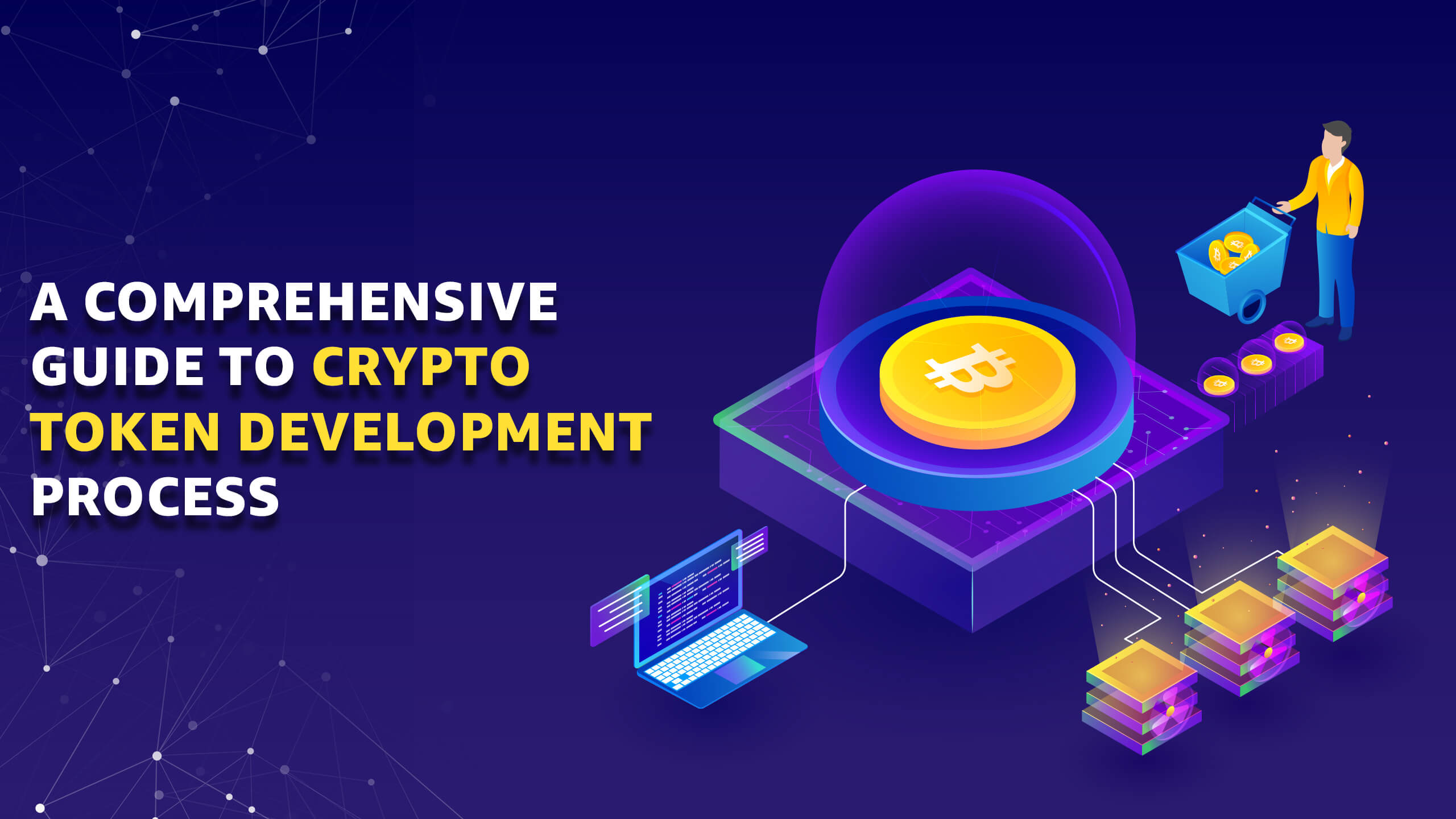With the advent of blockchain technology, the need to develop custom tokens different from the native cryptocurrencies has skyrocketed in recent times. The demand has escalated to a point where a 2023 survey revealed the global valuation of the tokenization market to be approximately $2.81 billion and projected to reach a whopping value of $13.20 billion by 2032. These tokens can be considered as the replica of digital assets, deployed on existing blockchains. However, they possess their characteristics and valuations, much different from the native tokens of the concerned blockchain.
Owing to this, crypto token development has become a hyped topic in today’s DeFi ecosystem. Creating and deploying new tokens based on smart contracts requires in-depth domain knowledge and expert technical prowess. With this being said, we have curated a detailed guide on the development cycles of crypto tokens for a personal infrastructure utilizing an existing blockchain.
Working on Crypto Tokens and Their Behavior
Crypto tokens can be considered digital assets built and deployed to existing blockchain ledgers and meant to signify or represent real-world entities. For example, these tokens can symbolize equities in a company, real estate plot, and even tangible objects like merchandise and gaming purchases. They can be easily transferred, created, and managed over the blockchain, following decentralized protocols and creating end-to-end transparency and immutability.
The working of crypto tokens can be defined based on their types or categories. These are:
- Utility tokens: These allow users access to specific systems or assets by implementing strong encryption and password-protected layers.
- Security tokens: These entities represent the ownership of a user for a particular real-world object, like shares and dividends in a company or a real estate plot.
- Governance tokens: Owners can leverage these tokens to exercise voting rights and decision-making powers within a decentralized autonomous organization.
- RWA tokens: One of the most popular token categories prevalent in the decentralized market is the RWA or real-world asset token as they represent real-world entities, especially ownerships.
- Stable coins: With these entities, owners can maintain the price at a stable value by pegging the valuation to another asset.
- Non-fungible token: NFTs are used to represent ownership of unique assets or systems within the decentralized ecosystem, especially gaming purchases, metaverse objects, and many more.
Crypto Token VS Crypto Coins: A Brief Parallel Study
People often get confused between crypto coins and tokens, which is why they fail to harness the true potential of either entity. Before you hire professional token development services, it’s imperative to know the differences between tokens and coins briefly.
Crypto Tokens |
Crypto Coins |
| These digital entities are used to represent ownership and can be considered project assets within the decentralized ecosystem. | Coins are digital currencies that can be used to make payments on the blockchain or purchase any other object through selling. |
| Crypto tokens are not specific to any particular blockchain and can be transferred from one to another with ease. | Crypto coins are developed for a specific blockchain and cannot be used outside its ledger by any means. |
| Tokens are used for numerous purposes, like providing security of ownership and granting governance rights. | Coins are specifically mined to make payments through the blockchain ledger within the DeFi ecosystem. |
| Smart contracts are primarily used to define the governing principles and working methodology for crypto token development. | Crypto coins can be mined and earned through different consensual protocols, like Proof of Work and Proof of Stake. |
Key Features of Crypto Tokens to Consider
Every company offering token development services considers a list of specific features for the digital assets. These lay the cornerstone of the decentralized behavior of the crypto tokens and make them stand out from traditional currencies. So, below we have briefly explained a couple of these features you must have in the crypto tokens to be developed.
1. Anonymity: The transactions initiated with crypto tokens do not reveal the person’s identity or company details. Instead, every transaction is paired with a series of random but unique alphanumeric character sequences. This way, these tokens ensure complete anonymity and protect the privacy of every individual user involved with the transaction.
2. Decentralization: Unlike traditional tokens, crypto tokens behave like decentralized assets, meaning they do not involve any third-party governing body. They do not require authentication or validation, which is why transactions get completed at lightning speed. Also, it is due to the decentralized behavior that crypto tokens pave the way for borderless transactions.
3. Immutability: Every transaction detail concerning the crypto tokens gets added to the blockchain ledger in the form of blocks. Once added, the information cannot be forged or manipulated, owing to end-to-end immutability. This way, the tokens ensure optimal transparency and credibility of the transactions.
4. Blockchain-independent: One of the major features of crypto token development is that these entities are blockchain-independent, meaning they can be transferred from one blockchain to another without making significant modifications in their coding or underlying architecture.
5. Security: Also, crypto tokens are highly secured via multi-layer authentication and cryptographic encryption protocols. As a result, users can easily initiate transactions without worrying about any manipulation.
Step-by-Step Explanation of Crypto Token Development
The entire process of crypto token development can be segregated into multifaceted steps, each having a dedicated purpose. So, it’s imperative to gain a deeper understanding of these phases for a successful SDLC process.
Requirement Evaluation
Firstly, you need to evaluate your business needs for the new crypto tokens. For example, the type of the new crypto tokens will depend on your intent of purpose, like security tokens to protect asset ownership and governance tokens to have voting and decision-making rights within the DAO. Apart from this, you should also decide the blockchain that you want to target using the crypto tokens. It will help the developers to utilize the underlying architecture of the blockchain to deploy the digital tokens.
Defining Token Attributes
The next step will require you to define the appropriate attributes you want the token to have. These will include the token name, the total supply volume of the entity, and the valuation to be assigned to individual tokens. You must define these attributes beforehand so that developers can work on the smart contract without having to modify the conditions and rules from scratch. If you want to develop non-fungible tokens, it’s important to declare ownership so that these entities can be further used to represent the dedicated assets or systems.
Developing the Smart Contract
Smart contracts are auto-executable computational programs that govern the functional behavior and transaction execution of the crypto tokens. These need to be deployed to the concerned blockchain where you want to leverage the tokens for transactions, ownership transfers, and other purposes. While developing the smart contracts, the following are some of the key considerations that should be made.
- Security protocols: Smart contracts are quite vulnerable to unethical hacking activities, owing to which you should discuss the authentication systems and other security protocols to be implemented during token development.
- Regulation: Since these will be executed digitally, a proper set of regulations should be defined for establishing consistency in their behavior, like taxation policies and others.
- Rules: Every smart contract executes itself based on specific rulesets. So, you should define these attributes properly, like the validation rules for a transaction and the total volume of crypto tokens that can be transacted once.
- Conditions: Another important attribute that needs to be defined for developing smart contracts is condition. It will govern the functional behavior of smart contracts and define the situations that can trigger the self-executable property of the contract.
Running Unit and QA Testing
Once the smart contracts are developed properly, you should run a proper unit testing schedule to ensure they function as per the pre-defined project scope. It is important to run the smart contracts on a blockchain so as to determine the interim bugs and get them resolved so that transaction execution can be completed without any hassle.
Deploying to the Blockchain
After the testing cycle is complete, developers will send the compiled contract codes through a transaction but without defining any receiver. All the functions of the smart contract should be validated and documented before deploying the same to the manner of the blockchain. Otherwise, it will immediately create a disruption and put the entire ledger on hold.
Conclusion
In this article, we have described the entire process of crypto token development, from project requirement evaluation to deploying the smart contracts to the main blockchain ledger. From the descriptions, it’s evident that developing a crypto token using smart contracts won’t be easy, which is why hiring a professional company for the same is necessary. They will add more value to your project idea by leveraging their market expertise and technological prowess.
Apart from this, you should ensure the design phase is thoroughly conducted so that token economics and other attributes can be aligned with your business requirements. Rest assured, crypto tokens will pave the way for utilizing the decentralized ecosystem to control ownership of real-world assets and exercise governance rights.
 +91 95109 87700
+91 95109 87700 +44 20 3290 3710
+44 20 3290 3710




